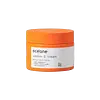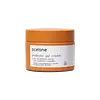What's inside
What's inside
 Key Ingredients
Key Ingredients

 Benefits
Benefits

 Concerns
Concerns

 Ingredients Side-by-side
Ingredients Side-by-side

Water
Skin ConditioningCoco-Caprylate/Caprate
EmollientC10-18 Triglycerides
EmollientDimethicone
EmollientHydrogenated Polyisobutene
EmollientAluminum Starch Octenylsuccinate
AbsorbentCetyl Alcohol
EmollientGlyceryl Stearate
EmollientNiacinamide
SmoothingMethylpropanediol
SolventAscorbic Acid
AntioxidantSodium Hyaluronate
HumectantHydrolyzed Hyaluronic Acid
HumectantSodium Acetylated Hyaluronate
HumectantMelaleuca Alternifolia Leaf Extract
PerfumingCeramide NP
Skin ConditioningCholesterol
EmollientStearic Acid
CleansingCaprylic/Capric Triglyceride
MaskingPhytosphingosine
Skin ConditioningOleic Acid
EmollientLactic Acid
BufferingHydrogenated Lecithin
EmulsifyingSorbitan Isostearate
EmulsifyingPolysorbate 60
EmulsifyingHydroxyethyl Acrylate/Sodium Acryloyldimethyl Taurate Copolymer
Emulsion StabilisingPEG-75 Stearate
Ceteth-20
CleansingSteareth-20
CleansingDimethiconol
EmollientCarrageenan
Sucrose
HumectantBetaine
HumectantAllantoin
Skin ConditioningTromethamine
Buffering1,2-Hexanediol
Skin ConditioningHydroxyacetophenone
AntioxidantCI 19140
Cosmetic ColorantWater, Coco-Caprylate/Caprate, C10-18 Triglycerides, Dimethicone, Hydrogenated Polyisobutene, Aluminum Starch Octenylsuccinate, Cetyl Alcohol, Glyceryl Stearate, Niacinamide, Methylpropanediol, Ascorbic Acid, Sodium Hyaluronate, Hydrolyzed Hyaluronic Acid, Sodium Acetylated Hyaluronate, Melaleuca Alternifolia Leaf Extract, Ceramide NP, Cholesterol, Stearic Acid, Caprylic/Capric Triglyceride, Phytosphingosine, Oleic Acid, Lactic Acid, Hydrogenated Lecithin, Sorbitan Isostearate, Polysorbate 60, Hydroxyethyl Acrylate/Sodium Acryloyldimethyl Taurate Copolymer, PEG-75 Stearate, Ceteth-20, Steareth-20, Dimethiconol, Carrageenan, Sucrose, Betaine, Allantoin, Tromethamine, 1,2-Hexanediol, Hydroxyacetophenone, CI 19140
Ingredients Explained
These ingredients are found in both products.
Ingredients higher up in an ingredient list are typically present in a larger amount.
1,2-Hexanediol is a synthetic liquid and another multi-functional powerhouse.
It is a:
- Humectant, drawing moisture into the skin
- Emollient, helping to soften skin
- Solvent, dispersing and stabilizing formulas
- Preservative booster, enhancing the antimicrobial activity of other preservatives
Carrageenan comes from red seaweed or algae. It is made up of polysaccharides and a highly flexible compound. Red algae cell walls are rich in carrageenan.
In cosmetics, it helps to thicken the texture. Studies show carrageenan extracted from red algae possess antioxidant properties. Components found in carrageenan include: lipids, fatty acids, Vitamin E, proteins, and several amino acids.
Learn more about different types of algae.
Carrageenan is also commonly used in medicine and food. It is a vegan alternative to animal-based gelatin.
Learn more about CarrageenanHydroxyacetophenone is antioxidant with skin conditioning and soothing properties. It also boosts the efficiency of preservatives.
This ingredient is not irritating or sensitizing.
Methylpropanediol is a synthetic solvent and humectant.
As a solvent, it helps dissolve other ingredients, helping to evenly distribute ingredients throughout the product. This ingredient has also been shown to have antimicrobial properties which makes it a preservative booster.
Methylpropanediol is able to add a bit of moisture to the skin. It also helps other ingredients be better absorbed into the skin, such as salicylic acid.
Learn more about MethylpropanediolWater. It's the most common cosmetic ingredient of all. You'll usually see it at the top of ingredient lists, meaning that it makes up the largest part of the product.
So why is it so popular? Water most often acts as a solvent - this means that it helps dissolve other ingredients into the formulation.
You'll also recognize water as that liquid we all need to stay alive. If you see this, drink a glass of water. Stay hydrated!
Learn more about Water